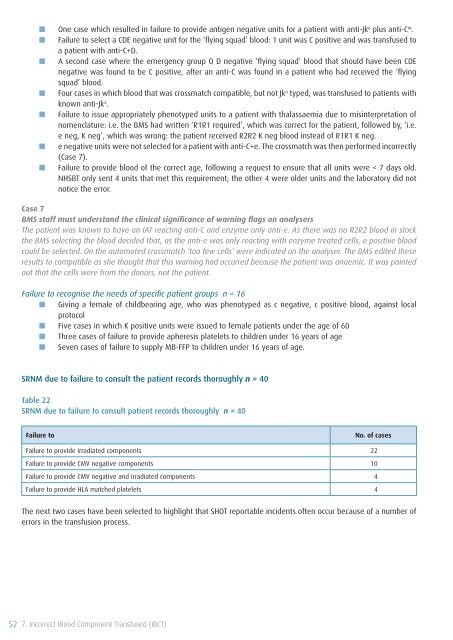SHOT Annual Report 2009 - Serious Hazards of Transfusion
SHOT Annual Report 2009 - Serious Hazards of Transfusion
SHOT Annual Report 2009 - Serious Hazards of Transfusion
Create successful ePaper yourself
Turn your PDF publications into a flip-book with our unique Google optimized e-Paper software.
a<br />
■■<br />
One case which resulted in failure to provide antigen negative units for a patient with anti-Jk plus anti-C w .<br />
■■ Failure to select a CDE negative unit for the ‘flying squad’ blood: 1 unit was C positive and was transfused to<br />
a patient with anti-C+D.<br />
■■ A second case where the emergency group O D negative ‘flying squad’ blood that should have been CDE<br />
negative was found to be C positive, after an anti-C was found in a patient who had received the ‘flying<br />
squad’ blood.<br />
a<br />
■■<br />
Four cases in which blood that was crossmatch compatible, but not Jk typed, was transfused to patients with<br />
known anti-Jk a .<br />
■■ Failure to issue appropriately phenotyped units to a patient with thalassaemia due to misinterpretation <strong>of</strong><br />
nomenclature: i.e. the BMS had written ‘R1R1 required’, which was correct for the patient, followed by, ‘i.e.<br />
e neg, K neg’, which was wrong: the patient received R2R2 K neg blood instead <strong>of</strong> R1R1 K neg.<br />
■■ e negative units were not selected for a patient with anti-C+e. The crossmatch was then performed incorrectly<br />
(Case 7).<br />
■■ Failure to provide blood <strong>of</strong> the correct age, following a request to ensure that all units were < 7 days old.<br />
NHSBT only sent 4 units that met this requirement; the other 4 were older units and the laboratory did not<br />
notice the error.<br />
Case 7<br />
BMS staff must understand the clinical significance <strong>of</strong> warning flags on analysers<br />
The patient was known to have an IAT reacting anti-C and enzyme only anti-e. As there was no R2R2 blood in stock<br />
the BMS selecting the blood decided that, as the anti-e was only reacting with enzyme treated cells, e positive blood<br />
could be selected. On the automated crossmatch ‘too few cells’ were indicated on the analyser. The BMS edited these<br />
results to compatible as she thought that this warning had occurred because the patient was anaemic. It was pointed<br />
out that the cells were from the donors, not the patient.<br />
Failure to recognise the needs <strong>of</strong> specific patient groups n = 16<br />
■■ Giving a female <strong>of</strong> childbearing age, who was phenotyped as c negative, c positive blood, against local<br />
protocol<br />
■■ Five cases in which K positive units were issued to female patients under the age <strong>of</strong> 60<br />
■■ Three cases <strong>of</strong> failure to provide apheresis platelets to children under 16 years <strong>of</strong> age<br />
■■ Seven cases <strong>of</strong> failure to supply MB-FFP to children under 16 years <strong>of</strong> age.<br />
SRNM due to failure to consult the patient records thoroughly n = 40<br />
Table 22<br />
SRNM due to failure to consult patient records thoroughly n = 40<br />
Failure to<br />
No. <strong>of</strong> cases<br />
Failure to provide irradiated components 22<br />
Failure to provide CMV negative components 10<br />
Failure to provide CMV negative and irradiated components 4<br />
Failure to provide HLA matched platelets 4<br />
The next two cases have been selected to highlight that <strong>SHOT</strong> reportable incidents <strong>of</strong>ten occur because <strong>of</strong> a number <strong>of</strong><br />
errors in the transfusion process.<br />
52 7. Incorrect Blood Component Transfused (IBCT)












